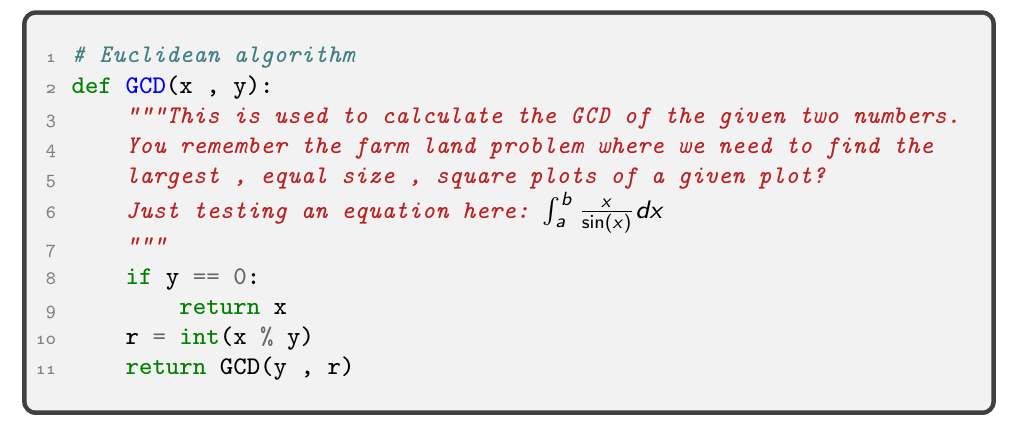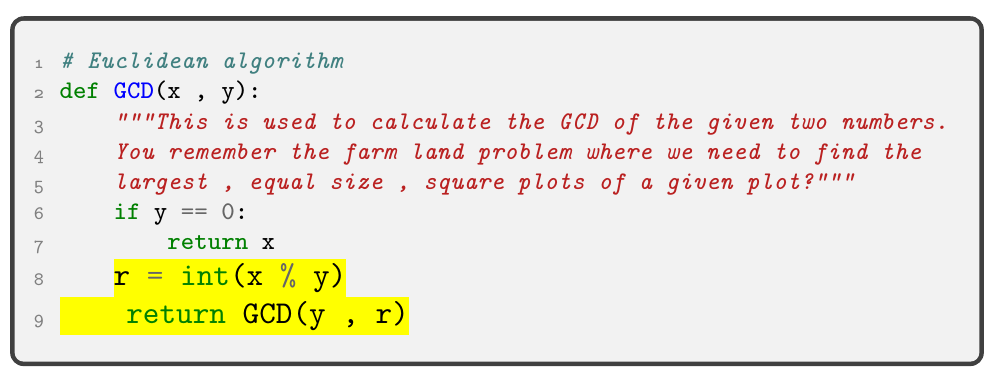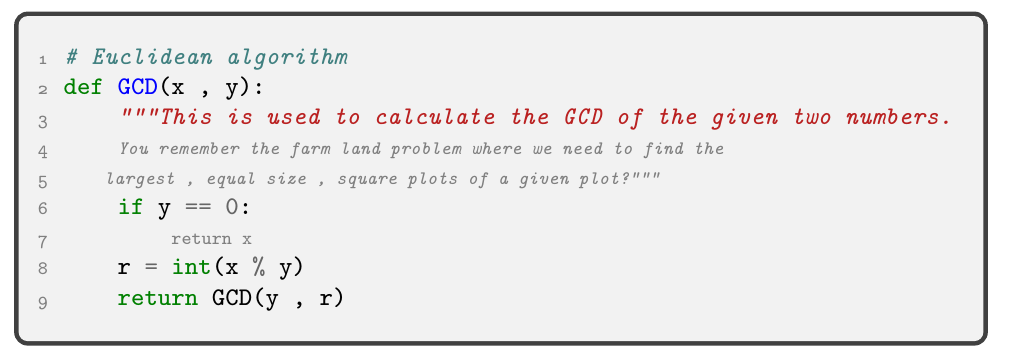Improving Pygments for Arbitrary LaTeX Escaping and Custom Highlighting
15 Jun 2021In LaTeX, the minted syntax highlighting package does not provide the ability to highlight/gray out certain code segments. The limitations of the LaTeX formatter in Pygments also makes it difficult to use escaped command sequences in strings or comments. In this post, I am sharing my ways of solving these two challenges. This is based on my answer to a TeX.SE question: Resources for “beautifying” beamer presentations with source code?.
In the current implementation of minted, one cannot escape contents in comments and strings. The escape sequence is also limited to one character long, which is inconvenient in practice. This problem can be fixed with the following file (my_pygmentize.py). It is essentially the same as pygmentize, but with the LatexEmbeddedLexer replaced with our own version. In the new implementation (LatexExtendedEmbeddedLexer), we can specify our own escape sequences in __init__ function. In this example, we used %* *). The _find_safe_escape_tokens function is modified so that we can escape contents anywhere in the code.
my_pygmentize.py
from pygments.token import Token
from pygments.lexer import Lexer, do_insertions
import pygments.formatters.latex as pygfmtlatex
class LatexExtendedEmbeddedLexer(pygfmtlatex.LatexEmbeddedLexer):
def __init__(self, left, right, lang, **options):
super().__init__('', '', lang, **options)
# define left and right delimieters here
self.left = '%*'
self.right = '*)'
# modified so that we can escape stuff in comments and strings
def _find_safe_escape_tokens(self, text):
for i, t, v in self._filter_to(
self.lang.get_tokens_unprocessed(text),
lambda t: False
):
if t is None:
for i2, t2, v2 in self._find_escape_tokens(v):
yield i + i2, t2, v2
else:
yield i, None, v
# replace LatexEmbeddedLexer
pygfmtlatex.LatexEmbeddedLexer = LatexExtendedEmbeddedLexer
# the rest is the same as pygmentize
import re
import sys
from pygments.cmdline import main
if __name__ == '__main__':
sys.argv[0] = re.sub(r'(-script\.pyw?|\.exe)?$', '', sys.argv[0])
sys.exit(main())
The next step is to implement our own formatter that supports highlight and gray out. Different from the existing LatexFormatter, I chose to format every character individually, because it is easier to implement background color in this way. However, as a trade-off, borders are not supported. To reduce the space of output material, I decided to define styles dynamically based on their occurrence in the code listing.
To support highlight/gray out, a check is added in the formatter. We can use special sequences to toggle highlight/gray out modes. For example, I used !!! to toggle highlight mode, and --- to toggle gray out mode. The exact behavior of each mode can be changed in the format_unencoded function.
myformatter.py
from io import StringIO
from pygments import highlight
from pygments.formatter import Formatter
import pygments.formatters.latex
from pygments.lexers.python import PythonLexer
from pygments.token import Token, STANDARD_TYPES
from pygments.util import get_bool_opt, get_int_opt
import copy
__all__ = ['LatexFormatter']
class Escaped:
def __init__(self, s):
self.s = s
def escape_tex(text, commandprefix):
return text.replace('\\', '\x00'). \
replace('{', '\x01'). \
replace('}', '\x02'). \
replace('\x00', r'\%sZbs' % commandprefix). \
replace('\x01', r'\%sZob' % commandprefix). \
replace('\x02', r'\%sZcb' % commandprefix). \
replace('^', r'\%sZca' % commandprefix). \
replace('_', r'\%sZus' % commandprefix). \
replace('&', r'\%sZam' % commandprefix). \
replace('<', r'\%sZlt' % commandprefix). \
replace('>', r'\%sZgt' % commandprefix). \
replace('#', r'\%sZsh' % commandprefix). \
replace('%', r'\%sZpc' % commandprefix). \
replace('$', r'\%sZdl' % commandprefix). \
replace('-', r'\%sZhy' % commandprefix). \
replace("'", r'\%sZsq' % commandprefix). \
replace('"', r'\%sZdq' % commandprefix). \
replace('~', r'\%sZti' % commandprefix). \
replace(' ', r'\%sZsp' % commandprefix)
def escape_tex_new(text, commandprefix):
chars = []
for c in text:
new_c = escape_tex(c, commandprefix)
if c != new_c:
chars.append(Escaped(new_c))
else:
chars.append(c)
return chars
DOC_TEMPLATE = r'''
\documentclass{%(docclass)s}
\usepackage{fancyvrb}
\usepackage{color}
\usepackage[%(encoding)s]{inputenc}
%(preamble)s
%(styledefs)s
\begin{document}
\section*{%(title)s}
%(code)s
\end{document}
'''
CMD_TEMPLATE = r'''
\newcommand\%(cp)sZbs{\char`\\}
\newcommand\%(cp)sZus{\char`\_}
\newcommand\%(cp)sZob{\char`\{}
\newcommand\%(cp)sZcb{\char`\}}
\newcommand\%(cp)sZca{\char`\^}
\newcommand\%(cp)sZam{\char`\&}
\newcommand\%(cp)sZlt{\char`\<}
\newcommand\%(cp)sZgt{\char`\>}
\newcommand\%(cp)sZsh{\char`\#}
\newcommand\%(cp)sZpc{\char`\%%}
\newcommand\%(cp)sZdl{\char`\$}
\newcommand\%(cp)sZhy{\char`\-}
\newcommand\%(cp)sZsq{\char`\'}
\newcommand\%(cp)sZdq{\char`\"}
\newcommand\%(cp)sZti{\char`\~}
\newcommand\%(cp)sZsp{\phantom{\space}}
%% for compatibility with earlier versions
\newcommand\%(cp)sZat{@}
\newcommand\%(cp)sZlb{[}
\newcommand\%(cp)sZrb{]}
'''
def _get_ttype_name(ttype):
fname = STANDARD_TYPES.get(ttype)
if fname:
return fname
aname = ''
while fname is None:
aname = ttype[-1] + aname
ttype = ttype.parent
fname = STANDARD_TYPES.get(ttype)
return fname + aname
class LaTeXStyleManager:
def __init__(self, prefix):
self.prefix = prefix
self.style_to_index_d = dict()
self.style_to_def_d = dict()
self.style_to_cmdname_d = dict()
self.toggle_styles = ['bold', 'italic', 'underline', 'roman', 'sans', 'mono']
self.toggle_style_cmds = [r'\bfseries', r'\itshape', r'\underline', r'\rmfamily', r'\sffamily', r'\ttfamily']
def number_to_base(self, n, b):
if n == 0:
return [0]
digits = []
while n:
digits.append(int(n % b))
n //= b
digits.reverse()
return digits
def number_to_base_zero_less(self, n, b):
digits = self.number_to_base(n, b)
digits.reverse()
i = 0
carry = False
while i < len(digits):
if carry:
digits[i] -= 1
carry = False
if digits[i] < 0:
carry = True
digits[i] = b + digits[i]
if digits[i] == 0:
if i < len(digits) - 1:
carry = True
digits[i] = b
i += 1
assert not carry
if digits[-1] == 0:
del digits[-1]
digits.reverse()
return digits
def int_to_alph(self, num):
base26 = self.number_to_base_zero_less(num + 1, 26)
a_cc = ord('a')
digits = [chr(a_cc + x - 1) for x in base26]
s = ''.join(digits)
return s
def get_style_def(self, style_ind, style_d, comment_str=None):
plain_defs = []
surround_defs = []
if style_d['cmd']:
plain_defs.append(style_d['cmd'])
for st in self.toggle_styles:
if style_d[st]:
if st == 'underline':
surround_defs.append(r'\underline')
else:
ind = self.toggle_styles.index(st)
plain_defs.append(self.toggle_style_cmds[ind])
if style_d['color']:
plain_defs.append(r'\color[HTML]{%s}' % style_d['color'].upper())
if style_d['bgcolor']:
surround_defs.append(r'\colorbox[HTML]{%s}' % style_d['bgcolor'].upper())
if style_d['bgcolor']:
def_string = ''.join(plain_defs) + r'\strut\relax#1'
else:
def_string = ''.join(plain_defs) + r'\relax#1'
for sd in surround_defs:
def_string = sd + '{' + def_string + '}'
if style_d['bgcolor']:
def_string = r'\setlength{\fboxsep}{0pt}' + def_string
def_string = r'\newcommand{\%s@%s}[1]{{%s}}' % (self.prefix, self.int_to_alph(style_ind), def_string)
if comment_str is not None:
def_string += '%' + comment_str
cmd_name = r'\%s@%s' % (self.prefix, self.int_to_alph(style_ind))
return def_string, cmd_name
def rgb_color(self, col):
if col:
return [int(col[i] + col[i + 1], 16) for i in (0, 2, 4)]
else:
return [0,0,0]
def get_default_style_d(self):
ds = dict()
for key in self.toggle_styles:
ds[key] = None
ds['color'] = None
ds['bgcolor'] = None
ds['cmd'] = ''
return ds
def style_to_tuple(self, style_d):
toggle_bits = [False] * len(self.toggle_styles)
for i in range(len(self.toggle_styles)):
if style_d[self.toggle_styles[i]]:
toggle_bits[i] = True
color = self.rgb_color(style_d['color'])
bg_color = self.rgb_color(style_d['bgcolor'])
cmd = style_d.get('cmd', '')
final = toggle_bits + [cmd] + color + bg_color
return tuple(final)
def has_style(self, style_d):
style_tup = self.style_to_tuple(style_d)
return style_tup in self.style_to_index_d
def get_style_index(self, style_d, comment_str=None):
style_tup = self.style_to_tuple(style_d)
if style_tup in self.style_to_index_d:
return self.style_to_index_d[style_tup]
else:
self.style_to_index_d[style_tup] = len(self.style_to_index_d)
st_ind = self.style_to_index_d[style_tup]
complete_def, cmd_name = self.get_style_def(st_ind, style_d, comment_str)
self.style_to_def_d[st_ind] = complete_def
self.style_to_cmdname_d[st_ind] = cmd_name
return st_ind
def merge_styles(self, style_ds):
sty = self.get_default_style_d()
for style_d in style_ds:
for key in self.toggle_styles:
sty[key] = sty[key] or style_d[key]
if style_d['color']:
sty['color'] = style_d['color']
if style_d['bgcolor']:
sty['bgcolor'] = style_d['bgcolor']
if 'cmd' in style_d:
sty['cmd'] += style_d['cmd']
return sty
def get_style_cmdname(self, tts, styles):
if len(tts) == 0:
return None
style_ds = []
for item in tts:
if isinstance(item, dict):
style_ds.append(item)
else:
style_ds.append(styles[item])
merged_style = self.merge_styles(style_ds)
comment_str = None
if not self.has_style(merged_style):
comment_str = '+'.join([str(x) for x in tts])
st_ind = self.get_style_index(merged_style, comment_str=comment_str)
return self.style_to_cmdname_d[st_ind]
class LatexFormatter(pygments.formatters.latex.LatexFormatter):
name = 'LaTeX'
aliases = ['latex', 'tex']
filenames = ['*.tex']
def __init__(self, **options):
Formatter.__init__(self, **options)
self.docclass = options.get('docclass', 'article')
self.preamble = options.get('preamble', '')
self.linenos = get_bool_opt(options, 'linenos', False)
self.linenostart = abs(get_int_opt(options, 'linenostart', 1))
self.linenostep = abs(get_int_opt(options, 'linenostep', 1))
self.verboptions = options.get('verboptions', '')
self.nobackground = get_bool_opt(options, 'nobackground', False)
self.commandprefix = options.get('commandprefix', 'PY')
self.texcomments = get_bool_opt(options, 'texcomments', False)
self.mathescape = get_bool_opt(options, 'mathescape', False)
self.escapeinside = options.get('escapeinside', '')
if len(self.escapeinside) == 2:
self.left = self.escapeinside[0]
self.right = self.escapeinside[1]
else:
self.escapeinside = ''
self.envname = options.get('envname', 'Verbatim')
self.style_manager = LaTeXStyleManager(prefix=self.commandprefix)
self._create_tt_to_style_d()
self._create_stylesheet()
def _create_tt_to_style_d(self):
self.tt_to_style_d = dict()
for ttype, ndef in self.style:
self.tt_to_style_d[ttype] = ndef
def format_unencoded(self, tokensource, outfile):
t2n = self.ttype2name
cp = self.commandprefix
segments = []
current_line = []
# define custom modes
# highlight mode
highlight_mode_d = copy.copy(self.tt_to_style_d[Token.Text])
highlight_mode_d['bgcolor'] = 'FFFF00'
highlight_mode_d['cmd'] = '\\small'
grayout_mode_d = copy.copy(self.tt_to_style_d[Token.Text])
grayout_mode_d['color'] = '808080'
grayout_mode_d['cmd'] = '\\tiny'
# define the toggle strings of different modes
mode_strings = ['!!!', '---']
mode_styles = [highlight_mode_d, grayout_mode_d]
mode_flags = [False] * len(mode_strings)
def flush_line():
nonlocal segments, current_line
if len(current_line) > 0:
segments.append(current_line)
current_line = []
toks = list(tokensource)
for ttype, value in toks:
new_value = []
if ttype in Token.Comment:
new_value.extend(escape_tex_new(value, cp))
value = escape_tex(value, cp)
elif ttype not in Token.Escape:
new_value.extend(escape_tex_new(value, cp))
value = escape_tex(value, cp)
raw_ttype = []
def write_content(cmdname=None, raw=False):
nonlocal current_line, new_value
real_cmdname = cmdname
if raw:
for item in new_value:
if isinstance(item, Escaped):
current_line.append(item.s)
else:
current_line.append(item)
else:
if real_cmdname is None:
real_cmdname = ''
for item in new_value:
if isinstance(item, Escaped):
current_line.append('%s{%s}' % (real_cmdname, item.s))
else:
if item == '\n':
flush_line()
continue
current_line.append('%s{%s}' % (real_cmdname, item))
if ttype in Token.Escape:
# deal with mode toggle strings
if value in mode_strings:
ind = mode_strings.index(value)
mode_flags[ind] = not mode_flags[ind]
else:
new_value.append(Escaped(value))
write_content(raw=True)
else:
while ttype is not Token:
raw_ttype.append(ttype)
ttype = ttype.parent
for i in range(len(mode_flags)):
if mode_flags[i]:
raw_ttype.append(mode_styles[i])
cmdname = self.style_manager.get_style_cmdname(raw_ttype, self.tt_to_style_d)
write_content(cmdname=cmdname)
flush_line()
if self.full:
realoutfile = outfile
outfile = StringIO()
# write the command definition
outfile.write('\\bgroup\n')
outfile.write('\\makeatletter\n')
style_defs = '\n'.join(self.style_manager.style_to_def_d.values())
outfile.write(style_defs + '\n')
outfile.write(r'\newcommand{\PYG@COMMAND@PREFIX}{%s}' % cp + '\n')
outfile.write(r'\newcommand{\PYG@NUM@STYLES}{%d}' % len(self.style_manager.style_to_index_d) + '\n')
outfile.write(CMD_TEMPLATE % {'cp': cp})
outfile.write('\\begin{' + self.envname + '}[commandchars=\\\\\\{\\}')
if self.linenos:
start, step = self.linenostart, self.linenostep
outfile.write(',numbers=left' +
(start and ',firstnumber=%d' % start or '') +
(step and ',stepnumber=%d' % step or ''))
if self.mathescape or self.texcomments or self.escapeinside:
outfile.write(',codes={\\catcode`\\$=3\\catcode`\\^=7'
'\\catcode`\\_=8\\relax}')
if self.verboptions:
outfile.write(',' + self.verboptions)
outfile.write(']\n')
all_lines = '\n'.join(map(lambda x : ''.join(x), segments))
outfile.write(all_lines + '\n')
outfile.write('\\end{' + self.envname + '}\n')
outfile.write('\\makeatother\n')
outfile.write('\\egroup\n')
if self.full:
encoding = self.encoding or 'utf8'
# map known existings encodings from LaTeX distribution
encoding = {
'utf_8': 'utf8',
'latin_1': 'latin1',
'iso_8859_1': 'latin1',
}.get(encoding.replace('-', '_'), encoding)
realoutfile.write(DOC_TEMPLATE %
dict(docclass = self.docclass,
preamble = self.preamble,
title = self.title,
encoding = encoding,
styledefs = '',
code = outfile.getvalue()))
In the next step, we need to hack minted so that it uses our lexer and formatter. This is achieved with the following file. We changed the executable from pygmentize to python3 my_pygmentize.py; and we used -x -f myformatter.py:LatexFormatter -P commandprefix=PY so that our own formatter is used. This code is quite long because I had to copy-paste the definition of \minted@pygmentize. Somehow \patchcmd doesn’t work with it.
patch_minted.tex
% patch \MintedPygmentize so that it uses our script
% this has to be placed after the preamble
\renewcommand{\MintedPygmentize}{python3 my_pygmentize.py}
% patch \minted@pygmentize so that it uses our own formatter
\makeatletter
\renewcommand{\minted@pygmentize}[2][\minted@outputdir\minted@jobname.pyg]{%
\minted@checkstyle{\minted@get@opt{style}{default}}%
\stepcounter{minted@pygmentizecounter}%
\ifthenelse{\equal{\minted@get@opt{autogobble}{false}}{true}}%
{\def\minted@codefile{\minted@outputdir\minted@jobname.pyg}}%
{\def\minted@codefile{#1}}%
\ifthenelse{\boolean{minted@isinline}}%
{\def\minted@optlistcl@inlines{%
\minted@optlistcl@g@i
\csname minted@optlistcl@lang\minted@lang @i\endcsname}}%
{\let\minted@optlistcl@inlines\@empty}%
\def\minted@cmd{%
\ifminted@kpsewhich
\ifwindows
\detokenize{for /f "usebackq tokens=*"}\space\@percentchar\detokenize{a in (`kpsewhich}\space\minted@codefile\detokenize{`) do}\space
\fi
\fi
\MintedPygmentize\space -l #2
-x -f myformatter.py:LatexFormatter -P commandprefix=PY -F tokenmerge % using custom formatter and prefix
\minted@optlistcl@g \csname minted@optlistcl@lang\minted@lang\endcsname
\minted@optlistcl@inlines
\minted@optlistcl@cmd -o \minted@outputdir\minted@infile\space
\ifminted@kpsewhich
\ifwindows
\@percentchar\detokenize{a}%
\else
\detokenize{`}kpsewhich \minted@codefile\space
\detokenize{||} \minted@codefile\detokenize{`}%
\fi
\else
\minted@codefile
\fi}%
% For debugging, uncomment: %%%%
% \immediate\typeout{\minted@cmd}%
% %%%%
\ifthenelse{\boolean{minted@cache}}%
{%
\ifminted@frozencache
\else
\ifx\XeTeXinterchartoks\minted@undefined
\ifthenelse{\equal{\minted@get@opt{autogobble}{false}}{true}}%
{\edef\minted@hash{\pdf@filemdfivesum{#1}%
\pdf@mdfivesum{\minted@cmd autogobble(\ifx\FancyVerbStartNum\z@ 0\else\FancyVerbStartNum\fi-\ifx\FancyVerbStopNum\z@ 0\else\FancyVerbStopNum\fi)}}}%
{\edef\minted@hash{\pdf@filemdfivesum{#1}%
\pdf@mdfivesum{\minted@cmd}}}%
\else
\ifx\mdfivesum\minted@undefined
\immediate\openout\minted@code\minted@jobname.mintedcmd\relax
\immediate\write\minted@code{\minted@cmd}%
\ifthenelse{\equal{\minted@get@opt{autogobble}{false}}{true}}%
{\immediate\write\minted@code{autogobble(\ifx\FancyVerbStartNum\z@ 0\else\FancyVerbStartNum\fi-\ifx\FancyVerbStopNum\z@ 0\else\FancyVerbStopNum\fi)}}{}%
\immediate\closeout\minted@code
\edef\minted@argone@esc{#1}%
\StrSubstitute{\minted@argone@esc}{\@backslashchar}{\@backslashchar\@backslashchar}[\minted@argone@esc]%
\StrSubstitute{\minted@argone@esc}{"}{\@backslashchar"}[\minted@argone@esc]%
\edef\minted@tmpfname@esc{\minted@outputdir\minted@jobname}%
\StrSubstitute{\minted@tmpfname@esc}{\@backslashchar}{\@backslashchar\@backslashchar}[\minted@tmpfname@esc]%
\StrSubstitute{\minted@tmpfname@esc}{"}{\@backslashchar"}[\minted@tmpfname@esc]%
%Cheating a little here by using ASCII codes to write `{` and `}`
%in the Python code
\def\minted@hashcmd{%
\detokenize{python -c "import hashlib; import os;
hasher = hashlib.sha1();
f = open(os.path.expanduser(os.path.expandvars(\"}\minted@tmpfname@esc.mintedcmd\detokenize{\")), \"rb\");
hasher.update(f.read());
f.close();
f = open(os.path.expanduser(os.path.expandvars(\"}\minted@argone@esc\detokenize{\")), \"rb\");
hasher.update(f.read());
f.close();
f = open(os.path.expanduser(os.path.expandvars(\"}\minted@tmpfname@esc.mintedmd5\detokenize{\")), \"w\");
macro = \"\\edef\\minted@hash\" + chr(123) + hasher.hexdigest() + chr(125) + \"\";
f.write(\"\\makeatletter\" + macro + \"\\makeatother\\endinput\n\");
f.close();"}}%
\ShellEscape{\minted@hashcmd}%
\minted@input{\minted@outputdir\minted@jobname.mintedmd5}%
\else
\ifthenelse{\equal{\minted@get@opt{autogobble}{false}}{true}}%
{\edef\minted@hash{\mdfivesum file {#1}%
\mdfivesum{\minted@cmd autogobble(\ifx\FancyVerbStartNum\z@ 0\else\FancyVerbStartNum\fi-\ifx\FancyVerbStopNum\z@ 0\else\FancyVerbStopNum\fi)}}}%
{\edef\minted@hash{\mdfivesum file {#1}%
\mdfivesum{\minted@cmd}}}%
\fi
\fi
\edef\minted@infile{\minted@cachedir/\minted@hash.pygtex}%
\IfFileExists{\minted@infile}{}{%
\ifthenelse{\equal{\minted@get@opt{autogobble}{false}}{true}}{%
\minted@autogobble{#1}}{}%
\ShellEscape{\minted@cmd}}%
\fi
\ifthenelse{\boolean{minted@finalizecache}}%
{%
\edef\minted@cachefilename{listing\arabic{minted@pygmentizecounter}.pygtex}%
\edef\minted@actualinfile{\minted@cachedir/\minted@cachefilename}%
\ifwindows
\StrSubstitute{\minted@infile}{/}{\@backslashchar}[\minted@infile@windows]
\StrSubstitute{\minted@actualinfile}{/}{\@backslashchar}[\minted@actualinfile@windows]
\ShellEscape{move /y \minted@outputdir\minted@infile@windows\space\minted@outputdir\minted@actualinfile@windows}%
\else
\ShellEscape{mv -f \minted@outputdir\minted@infile\space\minted@outputdir\minted@actualinfile}%
\fi
\let\minted@infile\minted@actualinfile
\expandafter\minted@addcachefile\expandafter{\minted@cachefilename}%
}%
{\ifthenelse{\boolean{minted@frozencache}}%
{%
\edef\minted@cachefilename{listing\arabic{minted@pygmentizecounter}.pygtex}%
\edef\minted@infile{\minted@cachedir/\minted@cachefilename}%
\expandafter\minted@addcachefile\expandafter{\minted@cachefilename}}%
{\expandafter\minted@addcachefile\expandafter{\minted@hash.pygtex}}%
}%
\minted@inputpyg}%
{%
\ifthenelse{\equal{\minted@get@opt{autogobble}{false}}{true}}{%
\minted@autogobble{#1}}{}%
\ShellEscape{\minted@cmd}%
\minted@inputpyg}%
}
\makeatother
An Example
To run this example, make sure:
my_pygmentize.py,myformatter.py, andpatch_minted.texare all in the working directory.python3andpygmentsare installed-shell-escapeis enabled
\documentclass{beamer}
\usepackage[T1]{fontenc}
\usepackage[skins,listings,minted]{tcolorbox}
\usepackage{xcolor}
\begin{document}
% must not include in the prealbme
\input{patch_minted.tex}
% declare listing style
\newtcblisting{mylisting}[1]{
listing engine=minted,
listing only,
minted language={#1},
minted options={
autogobble,
breaklines,
fontsize=\scriptsize,
linenos,
numbersep=5pt,
escapeinside=|| % the value here doesn't matter, it just has to be present
}
}
% redefine line number style
\renewcommand{\theFancyVerbLine}{\tiny\ttfamily\textcolor[rgb]{0.5,0.5,0.5}{\oldstylenums{\arabic{FancyVerbLine}}}}
\begin{frame}[fragile]
\begin{mylisting}{python}
# Euclidean algorithm
def GCD(x , y):
"""This is used to calculate the GCD of the given two numbers.
You remember the farm land problem where we need to find the
largest , equal size , square plots of a given plot?
Just testing an equation here: %*$\int_a^b \frac{x}{\sin(x)} dx$*)
"""
if y == 0:
return x
r = int(x % y)
return GCD(y , r)
\end{mylisting}
\end{frame}
\begin{frame}[fragile]
\begin{mylisting}{python}
# Euclidean algorithm
def GCD(x , y):
"""This is used to calculate the GCD of the given two numbers.
You remember the farm land problem where we need to find the
largest , equal size , square plots of a given plot?"""
if y == 0:
return x
%*!!!*)r = int(x % y)
return GCD(y , r)%*!!!*)
\end{mylisting}
\end{frame}
\begin{frame}[fragile]
\begin{mylisting}{python}
# Euclidean algorithm
def GCD(x , y):
"""This is used to calculate the GCD of the given two numbers.
%*---*)You remember the farm land problem where we need to find the
largest , equal size , square plots of a given plot?"""%*---*)
if y == 0:
%*---*)return x%*---*)
r = int(x % y)
return GCD(y , r)
\end{mylisting}
\end{frame}
\end{document}
Escaping content in strings

Highlight

Gray out
